
BACH TRIO SONATAS part 3: Sonatas 4–6
Part 3: Sonatas 4-6 The first movement of Sonata 4, BWV 528, survives as an ensemble piece in the opening of Cantata 76, set for oboe d’amore and viola da gamba with basso continuo. We.

Part 3: Sonatas 4-6 The first movement of Sonata 4, BWV 528, survives as an ensemble piece in the opening of Cantata 76, set for oboe d’amore and viola da gamba with basso continuo. We.

Part 2: Sonatas 1-3 Perky in its outer two fast movements, wistfully melancholy in the middle slow movement, Sonata 1, BWV 525, also survives in a contemporary manuscript as chamber music. The arrangement for violin.

part 1: our backstage view The first weekend in April, the Tempesta di Mare Chamber Players will perform the full set of Bach’s six trio sonatas, BWV 525–530. Though these pieces survive as a set.

What makes baroque music from Naples sound recognizably different from music from Venice and Rome, the other main centers of Italian baroque style? Much mention is made on forums like these—program books, liner notes and.

The undisputed giraffe of the baroque orchestra is the theorbo, that double-necked thing that has the body of a lute, is plucked like a lute, but has a ridiculous extension that makes the instrument stick.

Why the money title? We puzzled for a while over why Rittler’s 1000-Guilder Sonata, the second work on this program, has such an enigmatic title. Was it composed for a 1000-guilder commission? Is there a melody called “1000 Guilders”.

Tempesta’s upcoming program Women of Antiquity includes three arias by Georg Reutter, that call for a special instrument, the “salterio”, a hammered dulcimer whose name comes from the same root as “psaltry” in English. What.

Three Pieces for lute that share the stage in comfort. As I practice my way through the opening show of Tempesta’s very different 2020–2021 season, a program that happens to be my solo lute recital,.

3. The Great Composer: Anonymous Some of the names in Karl II’s music collection at Kroměříž are of known “thought leaders” in the field, composers whose music was widely known, respected and imitated by others..

2. The Archbishop’s Chateau The archbishop’s chateau, a UNESCO World Heritage site where the original manuscripts for our December concert repertoire are housed, stands just off the Great Square (Velké naměsty) in the the heart.